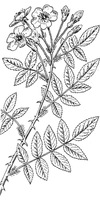 | Back to e-WV
| Back to e-WV
 The West Virginia Encyclopedia
The West Virginia Encyclopedia
 | Back to e-WV
| Back to e-WV
 The West Virginia Encyclopedia
The West Virginia Encyclopedia

Multiflora rose, a major agricultural nuisance, is a thorny non-native spreading shrub with high arching stems, reaching ten or more feet in height and often forming impenetrable thickets. Profuse clusters of single, one-inch white flowers appear in June, followed by quarter-inch red fruits in August.
Introduced to the eastern U.S. in 1866 as rootstock for ornamental roses, the multiflora rose was later promoted in the 1930s by the U.S. Soil Conservation Service for use in erosion control and as living fences. Multiflora rose was also encouraged as a source of food and cover for wildlife by state conservation departments as late as the 1960s, including the West Virginia Division of Natural Resources.
The shrub is extremely prolific and invades pastures and other unplowed lands, crowding out native vegetation. It is currently considered a noxious weed in several states, including West Virginia. Multiflora rose spreads aggressively, its large numbers of fruits eaten and dispersed by birds. Dense thickets of multiflora rose exclude most native shrubs and herbs from establishing and may reduce available nesting habitat for native birds.
Current efforts to control multiflora rose include frequent repeated cutting or mowing, pulling of young plants, use of herbicide, and in severe infestations, heavy equipment such as bulldozers. There are also two naturally occurring biological controls that affect multiflora rose to some extent: a native fungal pathogen (rose-rosette disease), spread by a tiny native mite, and a non-native seed-infesting wasp, the European rose chalcid. To date, rose-rosette disease shows the most promise for control of the invasive shrub, with more than 90 percent of many populations killed by the disease. Rose-rosette disease is spreading naturally through the East and Midwest.
Written by W. Russ McClain